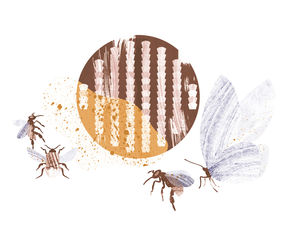
The Finnish Beekeepers' Association notes that bees have been kept as farm animals in Finland ever since the 18th century. Curator and artist Ulla Taipale says that bees get stressed and suffer from intensive farming methods just like other production animals.
Taipale leads the Melliferopolis project together with Austrian artist and researcher Christina Stadlbauer. In Finland, this project was launched in 2012 as part of Aalto University’s biological art programme Biofilia. The aim is to bring bees into urban environments, increase encounters between bees and people, and, through the means of art, improve knowledge and appreciation of bees.
“We want to highlight what would be lost if these pollinators were to disappear,” Taipale says.
The project has built different kinds of beehives in the Helsinki region, at the Kaisaniemi Botanic Garden and the Otaniemi campus, for example. In summer 2016, a bee runway, i.e. an eight-metre-long flowerbed, was added to a hive in Tarja Halonen Park. The runway was soon buzzing with a multitude of pollinators, winning over the hearts of local residents.
“When done in accordance with the principles of sustainable development, beekeeping aims to boost the wellbeing of bees and people alike instead of just maximising the efficiency of honey production. A balanced urban environment has to have green areas, and bees are necessary for plants.”
Bees are of course more than just flowerbed decorations. Taipale says that if bee colonies were to collapse, Finland would lose at least its blueberry, apple, cherry and courgette harvests. Around the world, crops like almonds and cocoa would be lost.
“Bees have already disappeared in some regions of China, forcing humans to pollinate fruit trees by hand. It’s slow work and raises the price of fruit.”
One way to protect bees would be to reintroduce them to urban life. Bees should not, however, be seen only as makers of honey, but as a lifeline for many plants.
Bees are also the focus of many prejudices and fears, and they are often confused with wasps. The Melliferopolis project has nevertheless already achieved results:
“At the start of the project, we had to persuade officials to allow us to place hives in the urban area, but now they are in high demand.”
Text: Tea Kalska. Illustration: Ida-Maria Wikström
This article is published in the Aalto University Magazine issue 22 (issuu.com), April 2018.
- Published:
- Updated:
Read more news

Student-driven projects to become Campus Sustainability Champions
This year, two student-led projects were selected as Campus Sustainability Champions. The awards were presented at the annual ACRE Day on 9 October 2024.
Prof. Yaolin Xu combines physics and chemistry for better batteries
Newly appointed Assistant Professor Xu looks to build up his lab and team at the Department of Applied Physics to pursue better batteries for a sustainable future in energy storage.
Vacant properties in Kouvola to be repurposed through circular economy
Aalto University students are seeking solutions to Kouvola city’s property challenges